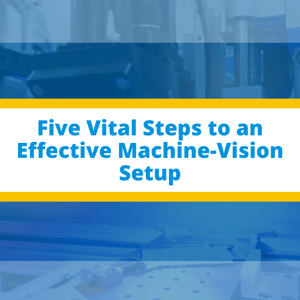 Machine Vision applications are complex and challenging due to their unique nature, and therefore require careful design to ensure maximum benefit for the investment made.
Machine Vision applications are complex and challenging due to their unique nature, and therefore require careful design to ensure maximum benefit for the investment made.
Step 1 – Determine Inspection Requirements
Studies have repeatedly indicated that humans are erroneous when it comes to inspections, due to our inability to focus for extended periods of time. Automated machine vision systems, however don’t have any such problems and are much more accurate, reliable and safe when used within such applications.
When a machine vision system is being setup, the first constraint that should be determined is the budget, and its comparison with the benefits that would be achieved by such an implementation. A cost-benefit analysis is necessary as at times human workers are better suited for the job, especially if inspection is seasonal or extremely complex for vision systems to handle. The latter in particular should be analyzed as too much complexity within vision systems would only raise the cost, and as per the budget, may make the implementation lose its edge.
Step 2 – Devise the Inspection Time
An alternative technology should be considered if the product’s inspection time differs by a factor of ten from the overall inspection time. While devising the inspection time, take into account material handling, image acquisition and data processing intervals. Specific techniques can be utilized that can then improve inspection-time performance, such as:
-
Digital cameras for faster image acquisition
-
MMX enabled vision software for increased system processing
-
High-end image acquisition hardware that can cut down processing times by focusing on specific segment of the images
In addition, the PCs used should have ample processing, storage and memory capabilities.
Step 3 – Identify Defects
Before machine vision hardware is procured, the definition of “defect” within a product should be clear as well as the aspect of the system that cannot be automated. Statistical techniques like ranking the defects from highest to lowest probabilities can be used to evaluate defects and classify them. One of the best ways to get through this step is to involve a systems integrator company.
A database of all defects or features can also be created to gain a clearer idea. For this, images can be taken through cheap digital cameras, frame grabbers, etc. so that a general strategy may be drawn up.
Step 4 – Choose Lighting
The lighting used for the vision system should properly position, highlight and illuminate the part under test. This is an extremely vital step as it improves the accuracy with which the vision system operates along with greater consistency throughout parts. The major goal when it comes to lighting should be to establish a homogeneous light area over the field of view and to clearly establish the presence of the part, separating it from the background. The latter is especially important as if the part doesn’t stand out from the background, the inaccuracy would increase.
Furthermore, ambient light must be considered as a factor which if not checked can add to inconsistency in the results during different times of the day. The lighting equipment should therefore be bright enough to block the surrounding light and minimize any issues that may arise.
Lighting techniques available in the market include but are not limited to strobe lighting, back lighting, dark field illumination, diffused lighting, and so on.
Step 5 – Picking the Optics
Minimum resolution and field-of-view requirements are two primary parameters when it comes to selecting a lens and camera for machine vision applications. The minimum resolution parameter determines the lens’s ability to find defects as small as 0.25mm within a vertical FOV of 20mm. For most applications, four pixels per the minimum defect size of 0.25mm is sufficient for error detection. In addition, the distance between the lens and the object should also be considered so that the focus can be determined properly.
From here on, the image-acquisition hardware is chosen which is generally a camera, analog or digital. The best way to do so is by bringing an SI or Vendor into the equation as they would be able to provide a solution according to the requirements gathered in the steps above, within the allocated budget. If the application for which machine vision system is being designed isn’t entirely green-lit, then catalogs and websites of vendors would be your best bet.

Interested in learning more? Visit our website www.premierautomation.com, or talk to one of our specialists today.



